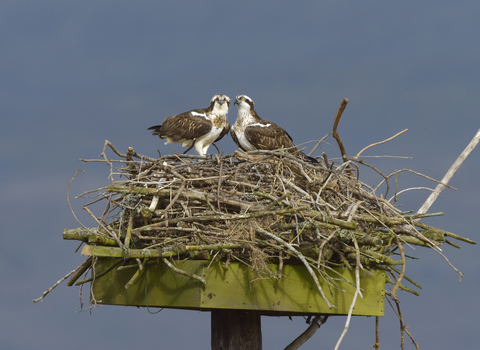Bringing ospreys back to Suffolk – our proposals
Watching an osprey hunting for fish is an amazing sight. This magnificent bird plunges at speed with its talons outstretched to catch fish swimming close to the surface of the water. The bird dives feet first into the water, and pulls itself free with strong, powerful wingbeats.
We now see ospreys on migration here in Suffolk for a few short days in spring and autumn, but it has been many hundreds of years since they have bred in the region.
We’d love to see them back, and we have an exciting plan to help them return.
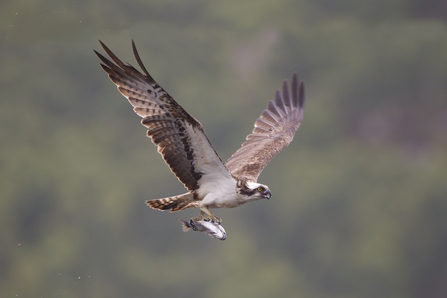
Osprey - Peter Cairns
Update: July 2023
Unfortunately, due to the ongoing situation with bird flu and the risk of possible transmission to the young ospreys, we have decided, along with our partners at Roy Dennis Wildlife Foundation, not to proceed with the project in 2023. We will review again, in the hope we will be able to proceed, in 2024. You can read more here.
A little bit of background
The osprey is a bird of prey that feeds exclusively on fish, and currently breeds in some parts of the UK thanks to careful conservation and successful translocation projects. It’s a bird that should be widespread across the UK and Europe but was brought to the brink of extinction due to relentless persecution and pesticide use. There is currently no breeding population of the birds in Suffolk or East Anglia.
UK-born ospreys spend March to September in Britain and migrate to warmer climates for the winter months. Ospreys migrate hundreds of miles to Spain or Portugal or continue across the Sahara to West Africa, a journey of 3000 miles.
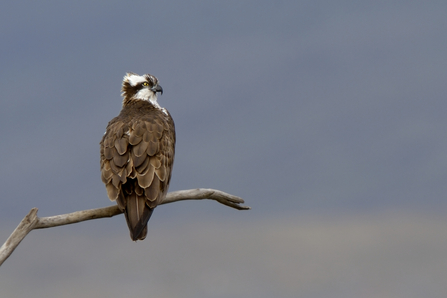
Male osprey - Andy Rouse
Why we want them back
Over the last 50 years, many conservationists have worked hard to help osprey populations recover from the effects of long-term persecution, habitat loss and pesticides. Ospreys became extinct as a breeding species in southern England during the Victorian age, and we want to restore the bird’s previous range. Having breeding ospreys in Suffolk will, after some years, mean the species will be able to expand its range up to Norfolk, down to Essex and across the wider East Anglia region. The osprey is part of a healthy ecosystem and its return will be one step closer to stemming the biodiversity loss we are all facing and help us create a wilder Suffolk.
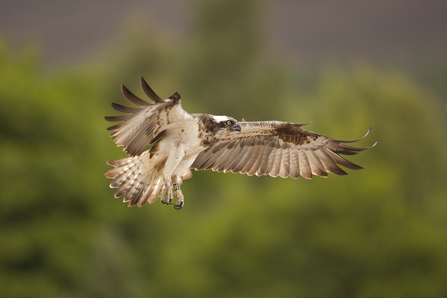
Osprey - Peter Cairns
What are our proposals?
Suffolk Wildlife Trust is working in partnership with Roy Dennis Wildlife Foundation, a local landowner and Leicestershire and Rutland Wildlife Trust. The Roy Dennis Wildlife Foundation has pioneered successful osprey translocation projects over the last few decades. We hope to replicate these using the same procedures.
The project is needed as ospreys are slow to spread to new areas. This is because males, in particular, are very faithful to the location from which they fledged. When a young osprey leaves its nest for the first time and begins to explore its surroundings, the geographical location is imprinted in its memory, and despite flying thousands of miles on migration, most young birds return to the same location and nest site. Translocation projects respond to this behaviour by moving juvenile ospreys a few weeks before they fledge to a new location, which will then become its imprinted home.
Females are a little more adventurous and are not so site-loyal until they find a nest and a mate. The aim is to create a self-sustaining population of breeding ospreys to enhance the species long-term chances of survival after intense and widespread persecution and to bring the majestic sight of the osprey back for everyone to enjoy.
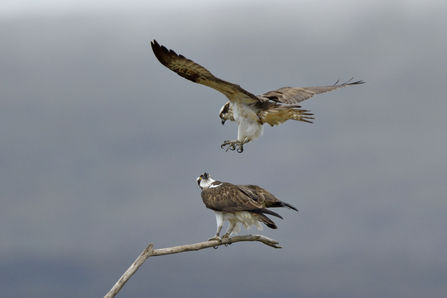
Ospreys preparing to mate - Andy Rouse
What we hope will happen...
The Suffolk coast and the Blyth estuary has the perfect habitat for ospreys to thrive with safe access to rivers and the estuary and plentiful fish, such as grey mullet.
Over a period of five years, we propose to move up to eight juvenile ospreys per year to Suffolk from the Rutland Water area in the East Midlands where a healthy population is now established following a successful translocation project. The young birds, around six-weeks old, would be collected from nests with more than one healthy chick. The populations in the donor sites will not be impacted negatively, and young will not be collected if there is an unsuccessful or poor breeding season. Collection is done quickly by experts under licence, meaning very little stress to adults or the chicks themselves.
In fact, the population around Rutland is now so abundant that young males are now competing for nest sites and females, sometimes inadvertently damaging or breaking eggs in the process. Our project will help by relocating surplus birds and allowing the population to spread to highly suitable habitat at a much faster rate than would occur naturally.
We are working in partnership with a local landowner and plan to build a purpose-built release pen to safely house the young ospreys for a short period before they are ready to fly. We will feed them fresh fish through a hatch for 2-3 weeks, so they have no contact with humans and remain totally wild. The birds will be monitored 24/7 through CCTV cameras.
When the young birds are ready to fledge, the door of the pen will be opened and the birds will be free to explore their surroundings and come and go as they wish. We will continue to provide fresh fish for them until they are ready to depart on their migration in the autumn, just as their parents would at a natural nest. Amazingly, young ospreys are not taught to fish by a parent, they have an innate ability to do this without watching the adult birds.
As they explore, we’ll track the young bird’s local movements in case they get into difficulty.
When they leave on migration, we won’t see the ospreys again until they return in the spring 2-3 years later. It will take at least three years for the first osprey to be ready to breed, and from then on, we hope we will have created a stable population that can then explore new nest sites and create a loose ‘colony’.
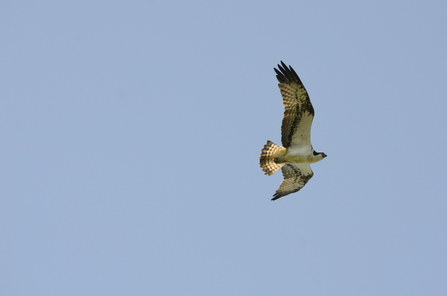
Osprey - David Tippling
Next steps
In 2024, we will reassess the evolving bird flu situation with Natural England and Roy Dennis Wildlife Foundation with the hope to proceed, assuming the Ospreys at Rutland Water have a successful breeding season.
Keep in touch
To receive updates on this and how our project is progressing, join our osprey mailing list. Thank you.

